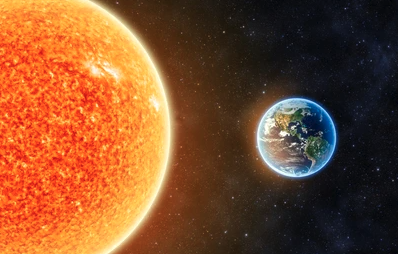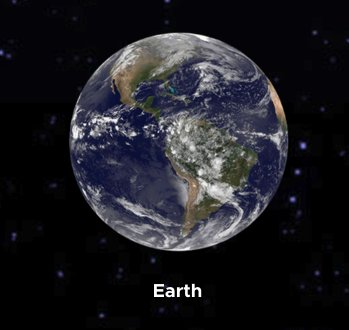How Far is the Sun From Earth?
The question, how far is the Sun from Earth? is one of the more interesting and fundamental questions in astronomy. It is essential to understand this distance as it helps scientists to study the properties of the Earth, the Sun, and the solar system as a whole.
The Earth’s distance from the Sun is approximately 93 million miles or 149.6 million kilometers. This distance is also known as an astronomical unit (AU), which is a standard measurement used in astronomy to measure distances within the solar system. The value of an AU is defined as the average distance between the Earth and the Sun, and it is used to measure distances within the solar system.

Table of Contents
How Do We Measure the Distance?
There are different methods used to measure the Earth’s distance from the Sun. One of the most common methods is the astronomical observation of the transit of Venus. During the transit of Venus, the planet passes directly between the Earth and the Sun. Astronomers use this event to measure the distance between the Earth and the Sun by observing the transit from different locations on Earth.
Another method used to measure the Earth’s distance from the Sun is radar ranging. In this method, a radar beam is sent from Earth to a planet or satellite, and the time it takes for the beam to return is measured. This method is very accurate and can measure distances up to several hundred million kilometers.
The Distance Between the Sun and the Earth Changes
The Earth’s distance from the Sun is not constant throughout the year. The orbit of the Earth is elliptical, meaning that the Earth is not always the same distance from the Sun. The closest point in the Earth’s orbit to the Sun is called perihelion, and the farthest point is called aphelion. The Earth is closest to the Sun in early January, and farthest from the Sun in early July. The distance between the Earth and the Sun at perihelion is about 91.4 million miles (147.1 million kilometers), while at aphelion it is about 94.5 million miles (152.1 million kilometers).
The Earth’s distance from the Sun has a significant impact on the planet and its inhabitants. The distance between the Earth and the Sun determines the amount of solar radiation that reaches the Earth’s surface. The intensity of solar radiation affects the temperature and climate of the planet, as well as the growth and survival of plants and animals. The Earth’s distance from the Sun also affects the length of the year, the timing of the seasons, and the duration of daylight.

The Earth’s distance from the Sun has been changing over time due to various factors. The gravitational pull of other planets, such as Jupiter and Saturn, can affect the Earth’s orbit and change its distance from the Sun. The Earth’s distance from the Sun can also be affected by solar flares and other space weather events. However, these changes are relatively small and do not have a significant impact on the Earth’s climate or environment.
How Far is the Sun from the Earth and Why is It Important?
The study of the Earth’s distance from the Sun is not only important for understanding the planet and the solar system, but it is also essential for human activities such as space exploration and satellite communications. Accurate knowledge of the Earth’s distance from the Sun is critical for planning and executing space missions, determining the orbits of spacecraft, and communicating with satellites.
For example, the NASA Voyager 1 and 2 spacecraft were launched in 1977 to explore the outer solar system. The distance between the Earth and the spacecraft had to be calculated accurately to ensure that the spacecraft would reach their intended destinations, such as Saturn, Uranus, and Neptune. The success of the Voyager missions was due in part to the accurate measurement of the Earth’s distance from the Sun.
Another example of the importance of accurate measurements of the Earth’s distance from the Sun is satellite communications. Satellites orbiting the Earth rely on the precise knowledge of their positions and orbits to provide communication services such as television broadcasting, mobile phone networks, and GPS navigation. The Earth’s distance from the Sun affects the position and orientation of satellites, and accurate measurements of this distance are essential for maintaining and improving satellite communication services.
What Does it Teach Us About Other Planets?
The Earth’s distance from the Sun is also important for understanding the habitability of other planets in the solar system and beyond. The habitable zone around a star is the region where the temperature and conditions are suitable for the existence of liquid water, which is essential for life as we know it. The habitable zone is determined by the star’s size and temperature, as well as the distance between the planet and the star. The Earth’s distance from the Sun is an example of a planet that is located in the habitable zone of its star.

The study of the Earth’s distance from the Sun has led to many discoveries and advancements in astronomy and space exploration. In 2012, the NASA Mars rover Curiosity was launched to explore the surface of Mars. The success of the mission was due in part to the accurate knowledge of the distance between Earth and Mars, which allowed the spacecraft to navigate to the planet’s surface and perform its scientific missions.
What Does it Teach Us About the Solar System?
The study of the Earth’s distance from the Sun has also led to new insights into the nature of the solar system and the universe as a whole. For example, astronomers have discovered thousands of exoplanets, or planets outside our solar system, using methods such as the transit method and radial velocity method. The study of the Earth’s distance from the Sun has played a crucial role in determining the habitability of these exoplanets and the potential for the existence of life on other planets.
Wrap Up
In conclusion, the study of the Earth’s distance from the Sun is a critical topic in astronomy and space exploration. Accurate measurements of this distance are essential for planning and executing space missions, maintaining and improving satellite communications, and understanding the habitability of other planets in the solar system and beyond. The Earth’s distance from the Sun has a significant impact on the planet’s climate, seasons, and daylight, and it is an essential concept for understanding the nature of the solar system and the universe as a whole. The continued study of the Earth’s distance from the Sun is essential for advancing our understanding of the universe and the potential for the existence of life on other planets.
